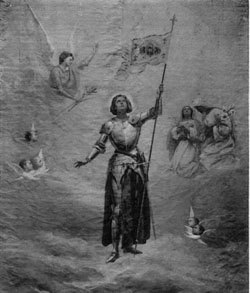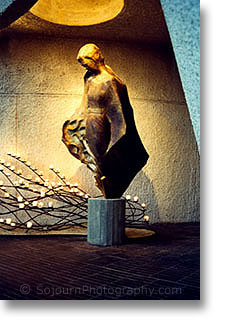|
If you’re anything like me, when I was first introduced
to Joan of Arc I really had no understanding of the process of becoming a saint, or
more formally, canonization. Once I discovered what being a saint meant I
had a renewed appreciation for our girl, Jehanne. The Catholic Church
reserves this title for holy souls who show heroic virtue and union with
Christ. Determining such a heavenly thing is arduous and difficult but once
it’s understood a true appreciation for Jehanne’s spiritual makeup might be
formed. So then, how does one be declared a saint and
what does it mean?
Beatification
The first and
often most difficult step is beatification. The promoters of the cause are
asked to vouch for four authentic miracles in order to secure
beatification. One miracle can be dispensed if the candidate has founded a
religious order. In Joan’s case, the Pope granted dispensation because she
had saved France. This seemed fair enough! So then, three approved miracles
were necessary for Joan’s beatification. Three nuns, all living in France,
received documented cures attributed to Joan of Arc’s intervention. These
miracles were accepted as authentic.
Once a person is beatified (or declared blessed), the faithful
are allowed to venerate these individuals. However, this is not universally recognized and
usually limited to the towns connected to the person.
Canonization
The next step, once beatification has been declared, is canonization. Two more miracles
must be proven for canonization. Two such miracles were attributed to Joan
of Arc which sealed her sainthood—a healing from tuberculosis and the
healing of a hole in the sole of a woman’s foot.
    
Joan of Arc's Journey to Sainthood
 Joan’s journey to sainthood started in the year 1449, when
Rouen, the city of Joan’s
martyrdom, was recaptured by the French. Eighteen years had transpired since
Joan’s burning. Her memory was not forgotten. In 1449, King Charles gave
orders to Guillame Bouillé, his counselor and theologian, to make an
investigation into her trial. The King wrote that he wished “to know the
truth about this trial and the manner in which it was conducted”. Bouillé
thoroughly examined seven witnesses and after hearing their testimonies was
convinced that the trial must be considered null and void. In his summary he
indicated that the King shouldn’t be associated with a person who had been
sentenced as a witch and a revision must be undertaken as soon as possible. Joan’s journey to sainthood started in the year 1449, when
Rouen, the city of Joan’s
martyrdom, was recaptured by the French. Eighteen years had transpired since
Joan’s burning. Her memory was not forgotten. In 1449, King Charles gave
orders to Guillame Bouillé, his counselor and theologian, to make an
investigation into her trial. The King wrote that he wished “to know the
truth about this trial and the manner in which it was conducted”. Bouillé
thoroughly examined seven witnesses and after hearing their testimonies was
convinced that the trial must be considered null and void. In his summary he
indicated that the King shouldn’t be associated with a person who had been
sentenced as a witch and a revision must be undertaken as soon as possible.
Trial of Rehabilitation
Politics obviously influenced this new trial; however, this doesn’t alter
the fact that the Trial of Rehabilitation brought much evidence to light,
clearly proving the illegality and numerous errors in procedure of the first
trial.
The new trial, the Trial of Rehabilitation, was opened
in Paris on November 7, 1455. Four examinations were held, one in Domrèmy,
Rouen, Orléans and
Paris, with one hundred and fifty witnesses heard.
The verdict declared the Trial of Condemnation
from 1431 was invalid on the grounds of procedure and the judges having lacked impartiality. In the Old Market
Square in Rouen, where Joan had been burned, a cross was raised in honor of
her injustice. The Trial of Rehabilitation was the first step in clearing
Joan’s good name. The evolution of her reputation from witch to holy maid
had begun.
Petitioning Pope Pius IX
Four hundred fourteen years later, in 1869, Bishop Dupanloup of Orléans had the ingenious
idea of inviting all the bishops of the towns which Joan had marched through
on her way to Reims to the annual May 8 commemoration of the town’s
liberation. The Bishop made an emotional speech about the importance of Joan
as a patriot and a Catholic. The eleven bishops present, along with Bishop
Dupanloup, made a solemn appeal to Pope Pius IX in Rome to begin the process of
canonization. Their appeal was the following:
“Not only Orléans and France but the whole world
venerate God’s acts through Joan of Arc, the piety and enthusiasm of this
young girl, the purity and unbending self-abnegation with which she always
carried out the will of God, as well as the reputation for holiness which
crowned her life both in Domremy, where she tended her father’s cattle as
a modest peasant girl, on the battlefield where she showed the skill and
courage of a great captain, and at the stake where she displayed her
unalterable loyalty to the Christian faith and the Apostolic See.
“The Roman Popes have already defended, shielded and
praised this admirable heroine, and it is the general wish that Your
Holiness now honor and exalt her memory. This would constitute a just
tribute to Joan, who in freeing her country also saved it from the heresy
which might have become a danger in the future. It would also constitute a
title of honor to the French people, who have done so much for religion
and for the Throne of Saint Peter, and who also have deserved the name of
‘God’s soldier’”.
In 1894, Rome began its work towards the Bishops’
petition. Joan’s beatification was decreed by Pope Pius X on April 11, 1909.
 Saint Joan of Arc Saint Joan of Arc
Joan was canonized with great festivity on May 16,
1920, in Saint Peter’s Basilica, finally restoring her reputation among the
faithful. That same year, the French government officially made May 8
a national holiday. Her celebrated feast day is May 30, the day of her
death.
Whether one is Catholic or not, Saint Joan of Arc
serves as an example of a holy soul who conformed herself to God’s will. She
was then given all necessary means to accomplish the tremendous tasks
appointed to her. In the words of Pope Pius X, “Joan has shone like a new
star destined to be the glory not only of France but of the Universal Church
as well.”
|



 Joan’s journey to sainthood started in the year 1449, when
Joan’s journey to sainthood started in the year 1449, when
 Saint Joan of Arc
Saint Joan of Arc